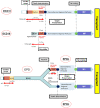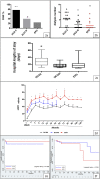Kidney Transplants From Donors on Extracorporeal Membrane Oxygenation Prior to Death Are Associated With Better Long-Term Renal Function Compared to Donors After Circulatory Death
- PMID: 35210934
- PMCID: PMC8862176
- DOI: 10.3389/ti.2021.10179
Kidney Transplants From Donors on Extracorporeal Membrane Oxygenation Prior to Death Are Associated With Better Long-Term Renal Function Compared to Donors After Circulatory Death
Abstract
Donation after circulatory death (DCD) allows expansion of the donor pool. We report on 11 years of Italian experience by comparing the outcome of grafts from DCD and extracorporeal membrane oxygenation (ECMO) prior to death donation (EPD), a new donor category. We studied 58 kidney recipients from DCD or EPD and collected donor/recipient clinical characteristics. Primary non function (PNF) and delayed graft function (DGF) rates, dialysis need, hospitalization duration, and patient and graft survival rates were compared. The estimated glomerular filtration rate (eGFR) was measured throughout the follow-up. Better clinical outcomes were achieved with EPD than with DCD despite similar graft and patient survival rates The total warm ischemia time (WIT) was longer in the DCD group than in the EPD group. Pure WIT was the highest in the class II group. The DGF rate was higher in the DCD group than in the EPD group. PNF rate was similar in the groups. Dialysis need was the greatest and hospitalization the longest in the class II DCD group. eGFR was lower in the class II DCD group than in the EPD group. Our results indicate good clinical outcomes of kidney transplants from DCD despite the long "no-touch period" and show that ECMO in the procurement phase improves graft outcome, suggesting EPD as a source for pool expansion.
Keywords: donation after circulatory death; eGFR; extracorporeal membrane oxygenation; hypothermic perfusion; renal transplantation.
Copyright © 2022 Gregorini, Ticozzelli, Abelli, Grignano, Pattonieri, Giacomoni, De Carlis, Dell’Acqua, Caldara, Socci, Bottazzi, Libetta, Sepe, Malabarba, Manzoni, Klersy, Piccolo and Rampino.
Conflict of interest statement
The authors declare that the research was conducted in the absence of any commercial or financial relationships that could be construed as a potential conflict of interest.
Figures


Similar articles
-
Kidney transplant from uncontrolled donation after circulatory death donors maintained by nECMO has long-term outcomes comparable to standard criteria donation after brain death.Am J Transplant. 2019 Feb;19(2):434-447. doi: 10.1111/ajt.14991. Epub 2018 Aug 16. Am J Transplant. 2019. PMID: 29947163
-
Comparison Between Kidney Transplantation After Circulatory Death and After Brain Death: A Monocentric Retrospective Study After 1 Year of Follow-up.Transplant Proc. 2020 Jun;52(5):1536-1538. doi: 10.1016/j.transproceed.2020.02.043. Epub 2020 Apr 4. Transplant Proc. 2020. PMID: 32252998
-
Kidney transplantation from donation after cardiac death donors: lack of impact of delayed graft function on post-transplant outcomes.Clin Transplant. 2011 Mar-Apr;25(2):255-64. doi: 10.1111/j.1399-0012.2010.01241.x. Clin Transplant. 2011. PMID: 20331689
-
Recipient and allograft survival following donation after circulatory death versus donation after brain death for renal transplantation: A systematic review and meta-analysis.Transplant Rev (Orlando). 2020 Oct;34(4):100563. doi: 10.1016/j.trre.2020.100563. Epub 2020 Jun 13. Transplant Rev (Orlando). 2020. PMID: 32576429
-
Kidney donation after circulatory death (DCD): state of the art.Kidney Int. 2015 Aug;88(2):241-9. doi: 10.1038/ki.2015.88. Epub 2015 Mar 18. Kidney Int. 2015. PMID: 25786101 Review.
Cited by
-
Liposome Formulation and In Vitro Testing in Non-Physiological Conditions Addressed to Ex Vivo Kidney Perfusion.Int J Mol Sci. 2022 Jul 20;23(14):7999. doi: 10.3390/ijms23147999. Int J Mol Sci. 2022. PMID: 35887348 Free PMC article.
-
Normothermic Regional Perfusion and Hypothermic Oxygenated Machine Perfusion for Livers Donated After Controlled Circulatory Death With Prolonged Warm Ischemia Time: A Matched Comparison With Livers From Brain-Dead Donors.Transpl Int. 2022 Apr 22;35:10390. doi: 10.3389/ti.2022.10390. eCollection 2022. Transpl Int. 2022. PMID: 35529593 Free PMC article.
-
Causes of Kidney Graft Failure in a Cohort of Recipients With a Very Long-Time Follow-Up After Transplantation.Front Med (Lausanne). 2022 Jun 6;9:842419. doi: 10.3389/fmed.2022.842419. eCollection 2022. Front Med (Lausanne). 2022. PMID: 35733857 Free PMC article.
-
Organ donation from extracorporeal membrane oxygenation and ventricular assist devices in Victoria, Australia: Characteristics and trends.Crit Care Resusc. 2025 Mar 13;27(1):100102. doi: 10.1016/j.ccrj.2025.100102. eCollection 2025 Mar. Crit Care Resusc. 2025. PMID: 40143832 Free PMC article.
-
The Evolving Role of Extracorporeal In Situ Perfusion Technology in Organ Donor Recovery with Donation After Circulatory Determination of Death Organ Donors.Medicina (Kaunas). 2025 Jul 15;61(7):1276. doi: 10.3390/medicina61071276. Medicina (Kaunas). 2025. PMID: 40731905 Free PMC article. Review.
References
-
- Rampino T, Abelli M, Ticozzelli E, Gregorini M, Bosio F, Piotti G, et al. Non-Heart-Beating-Donor Transplant: the First Experience in Italy. G Ital Nefrol (2010) 27:56–68. - PubMed
MeSH terms
LinkOut - more resources
Full Text Sources
Medical
Research Materials
Miscellaneous

